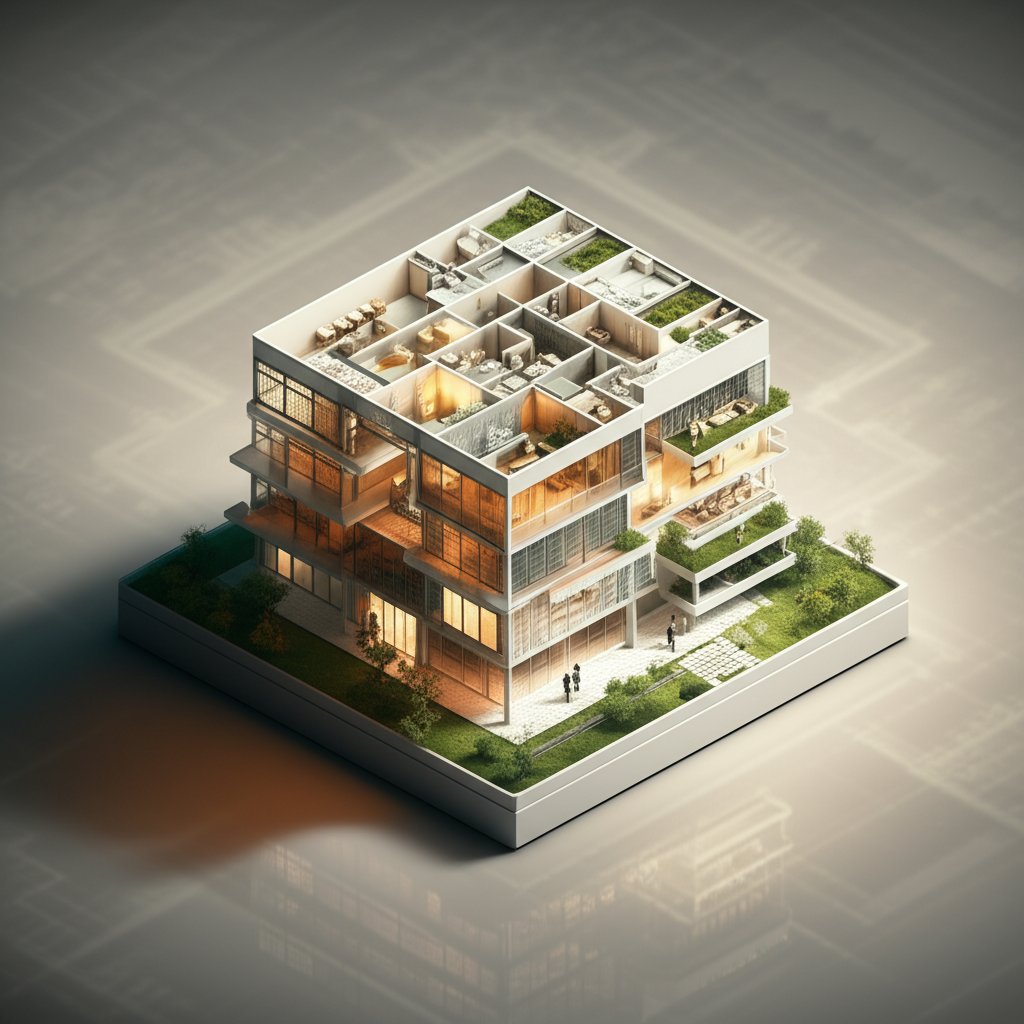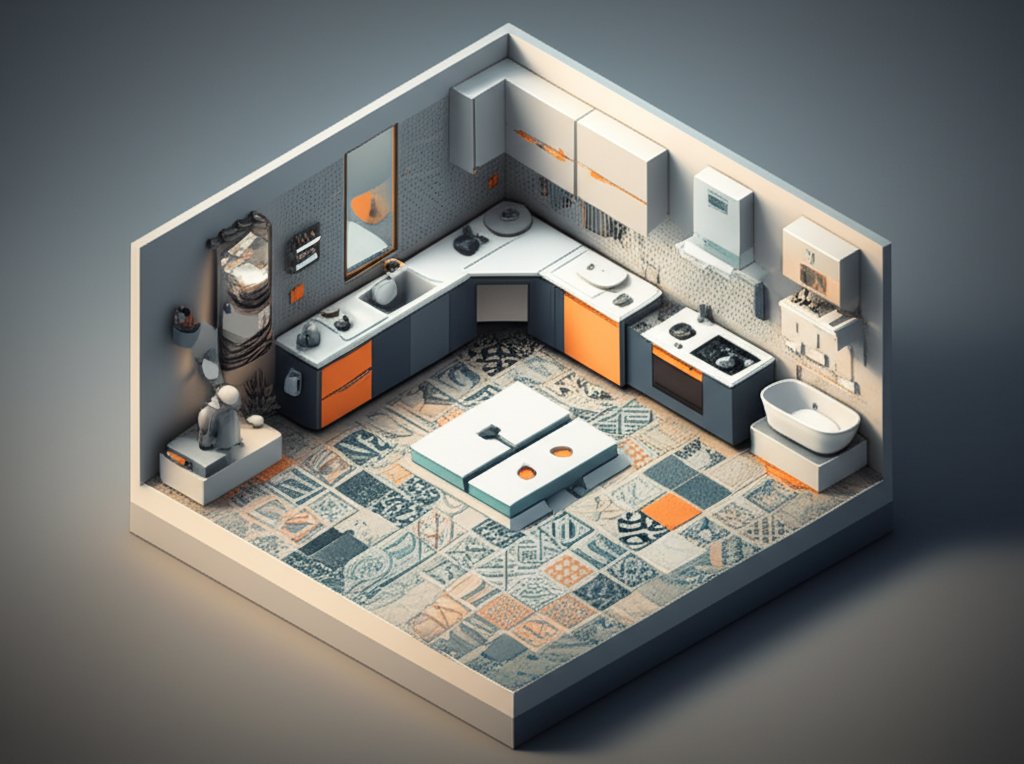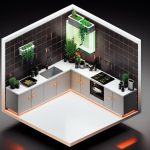For the bigger picture and full context, make sure you read our main guide on Colorful Backsplash Ideas: Brighten Your Kitchen With Tile.
The right backsplash material can make or break a kitchen or bathroom design, guarding your walls from splashes while adding personality. But with so many options, how do you choose? From classic tile to modern alternatives, understanding the nuances of each material is key.
At a glance, this article will help you:
- Identify the ideal backsplash materials based on your style and budget.
- Compare the pros and cons of popular options like tile, glass, and more.
- Learn how to choose the right colors and patterns for your space.
- Discover easy-to-implement design ideas for both kitchen and bathroom backsplashes.
- Confidently select backsplash materials that combine aesthetics with practicality.
Tile: The Timeless Choice
Tile remains king for backsplash materials, offering unmatched versatility in style, shape, and color. From the clean lines of subway tile to the intricate patterns of mosaic, tile can suit any design aesthetic.
Popular Tile Types:
- Ceramic: Budget-friendly and easy to maintain, ceramic is a solid all-around choice.
- Porcelain: More durable and water-resistant than ceramic, making it ideal for high-moisture areas.
- Glass: Adds a sleek, modern touch and reflects light beautifully, creating a sense of spaciousness.
- Recycled Glass: An eco-friendly option that adds unique character and visual interest.
Tile Shapes and Patterns: - Subway Tile: A classic, rectangular tile, often arranged in a staggered pattern for a timeless look. Experiment with different sizes, colors, and laying patterns (like herringbone) for a personal twist.
- Penny Tile: Tiny, round tiles that create a textured, vintage-inspired look. Often come on a webbed backing for easy installation.
- Hexagonal Tile: Six-sided tiles that offer a retro vibe. Available in various sizes and can be used to create eye-catching geometric patterns.
- Chevron Tile: Narrow, rectangular tiles arranged in a zig-zag pattern, adding a dynamic and modern element.
- Herringbone Tile: Similar to chevron, but with staggered breaks, creating a woven effect.
Practical Scenario: Imagine a modern farmhouse kitchen. White subway tile with contrasting dark grout provides a clean, classic backdrop. To add a touch of warmth, consider incorporating a small section of mosaic tile with natural stone accents above the stove.
Beyond Tile: Exploring Alternative Backsplash Materials
While tile is dominant, other materials offer unique advantages and aesthetics.
Glass: As mentioned above, glass backsplashes provide a sleek, ultra-modern look. They’re non-porous and easy to clean, ideal for minimalist kitchens or bathrooms. Glass also comes in tile formats.
Metal: Stainless steel, copper, or even brushed aluminum can create an industrial or contemporary vibe. Metal backsplashes are durable and heat-resistant, making them a practical choice for behind the cooktop.
Stone: Natural stone like granite, marble, or slate offers a luxurious and organic feel. However, stone is porous and requires sealing to prevent staining and water damage.
Brick: For an industrial or vintage aesthetic, consider a brick backsplash. You can use reclaimed brick for a rustic touch or opt for brick veneer for easier installation.
Wood: While not as common, wood backsplashes can add warmth and character to a kitchen or bathroom. Choose a water-resistant wood like teak or cedar, and seal it thoroughly for protection. Faux wood printed on other mediums is a great alternative.
Mirrors: Mirror backsplashes are excellent for making space look bigger and brighter.
Vinyl Wallpaper: Vinyl wallpapers offer a wide variety of styles and colors. This is also an excellent choice for renters since it is easily removable.
Color and Design Strategies for Backsplash Materials
The color and pattern of your backsplash can significantly impact the overall feel of your kitchen or bathroom. Here are a few options, depending on the surrounding text: * Find colorful backsplash ideas * Brighten your kitchen now * More colorful backsplash inspiration * See colorful tile backsplashes * Explore colorful backsplash guide to inspire your vision. When choosing backsplash materials, consider these design strategies:
- Monochromatic: Using different shades and tones of the same color creates a cohesive and sophisticated look. For example, a blue monochromatic backsplash could feature light sky blue, deep navy blue, and teal tiles.
- Neutral: A neutral palette of black, gray, white, cream, beige, or brown offers a timeless and versatile backdrop. This approach allows other elements in the room, like appliances or cabinetry, to take center stage.
- Complementary Colors: Using colors that are opposite each other on the color wheel (e.g., purple and yellow) can create a vibrant and energetic design. However, this approach requires careful consideration to avoid clashing.
- Warm vs. Cool Colors: Warm colors like red, orange, and yellow create a cheerful and inviting atmosphere, while cool colors like blue, green, and purple offer a calming and serene effect.
Practical Playbook: Selecting the Right Backsplash Material
Here’s a step-by-step guide to help you choose the perfect backsplash material:
- Assess Your Needs: Consider your budget, style preferences, and the level of maintenance you’re willing to undertake. Do you want something easy to clean? Do you want a statement piece or something more subtle?
- Explore Your Options: Research different materials and designs that align with your needs and preferences. Visit showrooms, browse online galleries, and gather inspiration from magazines and design blogs.
- Order Samples: Get samples of your favorite materials to see how they look and feel in your space. Consider the lighting and existing color scheme of your kitchen or bathroom.
- Consider Installation: Evaluate the complexity of installing your chosen material. Some materials, like tile, may require professional installation, while others, like peel-and-stick options, can be installed DIY.
- Factor in Maintenance: Understand the maintenance requirements of each material. Some materials, like natural stone, require regular sealing, while others, like glass, are relatively low-maintenance.
- Make Your Decision: Weigh the pros and cons of each option and make a decision based on your needs, preferences, and budget.
Decision Tree:
- High-Traffic Kitchen? Porcelain or stainless steel: durable, easy to clean.
- Budget-Conscious? Ceramic tile or vinyl wallpaper: affordable and stylish.
- Modern Aesthetic? Glass or metal: sleek and contemporary.
- Rustic Charm? Brick or natural stone: adds warmth and character.
- Small Space? Mirrored or light-colored tile: creates the illusion of spaciousness.
Quick Answers: Backsplash Material FAQs
Q: Is tile really the best option for a backsplash?
A: Tile is a great choice because it’s durable, resists water well, and offers almost limitless design options. However, it’s not always the best. Consider other options based on your specific needs and style.
Q: How do I clean a backsplash?
A: Most backsplashes can be cleaned with a mild detergent and water. For tougher stains, use a non-abrasive cleaner. Avoid using harsh chemicals that could damage the material.
Q: Can I paint over my existing tile backsplash?
A: Yes! If you like the layout of your current tile but not the color, painting it is an option. Choose a shiny paint with a hard coat, like an epoxy instead of latex, for a professional look.
Q: Are peel-and-stick backsplashes a good option?
A: Peel-and-stick backsplashes are a quick and easy way to update your kitchen or bathroom. They’re ideal for renters or those on a tight budget. However, they may not be as durable as traditional materials.
Q: What is the standard height for a kitchen backsplash?
A: The standard height for a kitchen backsplash is 18 inches, measured from the countertop to the bottom of the upper cabinets. However, you can adjust this height to suit your design preferences.
Q: How do I choose the right grout color for my tile backsplash?
A: Grout color can significantly impact the look of your backsplash. For a seamless look, choose a grout color that matches the tile. For a contrasting look, choose a grout color that is lighter or darker than the tile. Dark grout can also help hide dirt in a busy kitchen.
Backsplash Bliss: Your Turn to Design
Choosing the right backsplash materials is a crucial step in creating a kitchen or bathroom that reflects your personal style and meets your functional needs. By considering the factors outlined above, you can confidently select a backsplash that not only protects your walls but also enhances the beauty and value of your home. So, gather your inspiration, explore your options, and get ready to transform your space with the perfect backsplash.

- Choosing Backsplash Materials: Ideas for Kitchen and Bathroom Designs - November 12, 2025
- Kitchen Backsplash Tile Patterns: Find Your Perfect Style - November 11, 2025
- Colorful Kitchen Backsplash Ideas to Energize Your Cooking Space - November 10, 2025










